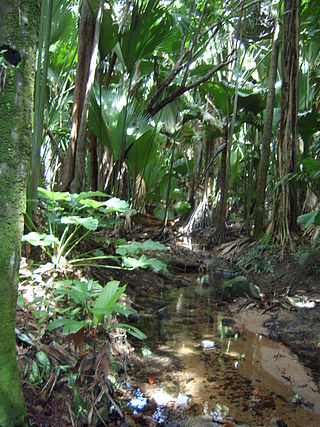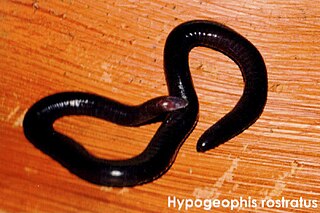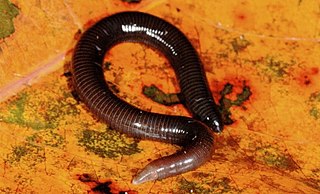
The Hyperoliidae, or sedge frogs and bush frogs, are a large family of small to medium-sized, brightly colored frogs which contains more than 250 species in 19 genera. Seventeen genera are native to sub-Saharan Africa. In addition, the monotypic genus Tachycnemis occurs on the Seychelles Islands, and the genus Heterixalus is endemic to Madagascar.

Sooglossidae, the Seychelles frogs or Seychelles Island frogs, are a family of frogs found on the Seychelles Islands. Until recently, this family was believed to include the genera Sechellophryne, Nesomantis and Sooglossus, but following a major revision of amphibians in 2006, the genus Nesomantis was named a junior synonym of Sooglossus. Their closest relatives are the purple frogs (Nasikabatrachidae) of India.

Vallée de Mai Nature Reserve is a nature park and UNESCO World Heritage Site on the island of Praslin, Seychelles. It consists of a well-preserved palm forest, flagship species made up of the island endemic coco de mer, as well as five other endemic palms.
Sooglossus is a genus of sooglossid frogs found in the Seychelles.
The Seychelles palm frog is a species of frog that is endemic to Silhouette Island in the Seychelles. It is closely related to Gardiner's frog, Sechellophryne gardineri.
Hypogeophis brevis is a species of caecilian formerly included in the genus Grandisonia and found on the islands of Mahé and Silhouette in the Seychelles. It is known only from two specimens collected on Mahé in 1910 and more collected recently from Silhouette.
Praslinia cooperi, or Cooper's black caecilian, is a species of caecilian in the family Grandisoniidae. It is monotypic in the genus Praslinia. It is found on Mahé and Silhouette Islands in the Seychelles. An old reported sighting on its namesake Praslin is not known to be correct.
Grandisonia alternans is a species of caecilian in the family Indotyphlidae, endemic to the Seychelles islands of Mahé, Praslin, Frégate, and La Digue.
Grandisonia larvata is a species of caecilian in the family Indotyphlidae, endemic to the Seychelles islands of Mahé, Praslin, La Digue, and Silhouette.
Grandisonia sechellensis is a species of caecilian in the family Indotyphlidae. It is endemic to the Seychelles islands of Mahé, Praslin, and Silhouette.
The Frigate Island caecilian is a species of amphibians in the family Indotyphlidae, endemic to Seychelles, where it is the most widespread caecilian species. It is found on all the islands with amphibians, namely Mahé, Praslin, Silhouette, Ste. Anne, Curieuse, La Digue, Cerf, and Frégate.

The Mascarene grass frog, or Mascarene ridged frog, is a species of frog in the family Ptychadenidae. It is found in sub-Saharan Africa, Madagascar, and Mauritius.

The wildlife of Seychelles comprises the flora and fauna of the Seychelles islands off the eastern coast of Africa in the western Indian Ocean.
Ver de terre is French for earthworm.

The Grandisoniidae are a family of common caecilians found in Africa, Seychelles and India. Like other caecilians, they superficially resemble worms or snakes. The family was formerly known as Indotyphlidae.

Hypogeophis is a genus of caecilians in the family Grandisoniidae. The genus consists of four species, all endemic to parts of the Seychelles Archipelago.

The Praslin National Park and surrounding areas Important Bird Area lies in the southern part of the island of Praslin in the Seychelles archipelago of the western Indian Ocean.

The Seychelles frog is a species of frog endemic to Mahé, Silhouette and Praslin islands in the Seychelles. It inhabits the floor of damp rainforest at altitudes from 150 m (490 ft) to 991 m (3,251 ft) above sea level. Higher altitude sites are considered to be more climatically stable and more suitable. The species is present in Morne Seychellois National Park, Silhouette National Park and Praslin National Park.









